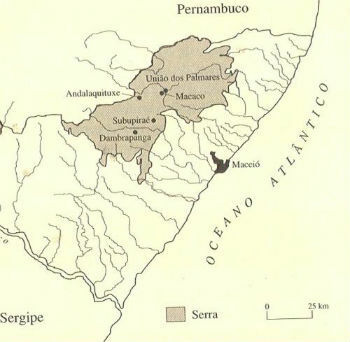O Quilombo dos Palmares it was one of the many quilombos of the Brazilian colonial era and its origin dates back to 1580.
Palmares was the refuge of fugitive slaves from plantations in the Captaincies of Pernambuco and Bahia.

What is Quilombo?
The word "quilombo” has Bantu etymology and refers to warrior camps in the forest.
It will be, however, in 1740, reporting to the king of Portugal, that the Overseas Council will define quilombo as:
"Every house of runaway blacks, over five, partly unpopulated, even if they don't have any houses built and no pestles are found in them."
However, among all the quilombos, the most emblematic was that of Palmares, which opposed colonial administration for nearly two centuries.
To better understand this concept, see the video below:
History: Summary
In the beginning, Palmares was populated by a few quilombolas.
However, the war against the Dutch has weakened colonial surveillance and hundreds of slaves flee to form the first population nucleus.
Although it appeared at the end of the 16th century, the heyday of Quilombo dos Palmares was in the second half of the 16th century.
The place was home to approximately 20 thousand quilombolas. The inhabitants subsisted on hunting, fishing and gathering fruits (mango, jackfruit, avocado and others), as well as agriculture (beans, corn, cassava, banana, orange and sugar cane).
In addition, the quilombolas produced handicrafts (baskets, fabrics, ceramics, metallurgy) and the surpluses were sold to neighboring populations. This generated a reasonably intense economy in the quilombo region.
The first king of Palmares was Denim Zumba, son of a princess of the Congo. His leadership was instrumental in organizing and resisting external attacks. He would later be replaced by Zumbi.
There was a difference between the status of quilombolas. These were divided between:
- those who arrived at the quilombos by their own means (most prestigious);
- those released by guerrilla incursions (disregarded and indicated for the heaviest jobs).
Note that Quilombo dos Palmares could be decomposed into several mocambos (population cores). This presupposes the political configuration of decentralization of power between different groups.
In Palmares we also find slavery. However, it was similar to that practiced among whites in Europe in the High Middle Ages, a voluntary and less degrading slavery.
Location
Quilombo dos Palmares was a safe haven for slaves who escaped from the region's plantations.
It was located in Serra da Barriga, in the state of Alagoas, a region covered with palm trees, hence its name.

state of Alagoas.
The Fall of Palmares
The prosperity of Palmares seduced the colonizers. With the expulsion of the Dutch from northeastern Brazil, the planters needed an increasing number of slaves to resume sugar production.
For this reason, Quilombo represented the possibility of obtaining labor, in addition to representing a dangerous example for slaves.
It took, however, eighteen campaigns to absolutely destroy the Quilombo dos Palmares.
After multiple ungrateful offensives against Palmares, the Portuguese court hires the pioneer Domingos Jorge Velho, experienced in the extermination war against the indigenous people.
However, even his troops had great difficulties in defeating the guerrilla tactics of the quilombolas. The quilombo would only come to an end soon after the death of its best-known leader, Zumbi.
The region of Quilombo dos Palmares grew after the defeat of the blacks. Over time, it became Vila Nova Imperatriz, elevated to the category of city on August 20, 1889.
However, it will be in 1944 that it will be named União dos Palmares in honor of the quilombo.
Zumbi dos Palmares

Born in Palmares, current state of Alagoas, in 1655, Zumbi dos Palmares he was the most prominent warrior chief in the history of the quilombo.
He was captured while still young and offered to Father Antônio Melo, who taught him Portuguese and Latin, in addition to baptizing him with the name of Francisco.
Years later, in 1670, he fled the parish and returned to Quilombo, where he became a leader by organizing the resistance.
That's why he earns the name Zumbi (military title of war chief) after devising a series of successful guerrilla strategies.
This included sudden assaults on the engenhos to free slaves and gain weapons, ammunition and supplies to carry out new attacks.
However, after several victories, including against expeditions by scout mercenaries, Zumbi was cornered and killed in November 1695.
His head is cut off and transported to Recife, where it was displayed in a public square. Thus, without Zumbi's military command, the quilombo completely disintegrated in 1710.
The "Day of Black Consciousness" is celebrated on November 20th. The date is a tribute to Zumbi dos Palmares and to all blacks who bravely fought against slavery.
Read too:
- Brazil Colony
- Slavery
- slavery in Brazil
- Brazilian Black Personalities


